GLOBE News
December 2018 News Brief left
Join the Trees Around the GLOBE Campaign Webinar 03 December: “Getting Tree Science Done: Live from Shumate Middle School”
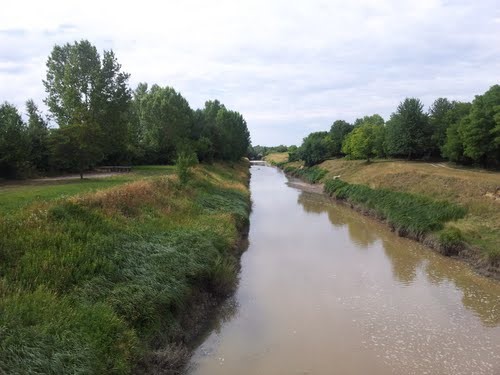
On Monday, 03 December, the Trees Around the GLOBE Student Research Campaign webinar “Getting Tree Science Done: Live from Shumate Middle School in Gibralter, Michigan” will be held at 8:00 p.m. EST (1:00 a.m. UTC).
During this webinar, participants will hear from GLOBE Teacher Jeff Bouwman and his students (Lily, Brady, and Thomas) as they discuss how doing GLOBE tree science at Shumate Middle School is helping them understand their local environment. Through measuring tree height, identifying tree species, and taking local baseline protocol measurements, the students play a vital role in helping the rest of the world understand how local environmental measurements are of global importance.
To register for the upcoming webinars and to receive emails about future webinars, click here. All the webinars can be joined at https://zoom.us/j/7578241037.
If you missed previous webinars, click here.
To learn more about the NASA ICESat-2 satellite mission, click here.
To learn more about the Trees Around the GLOBE campaign, including how to start taking measurements, how to retrieve relevant data, how to view ICESat-2 Satellite data, and how to connect to the campaign community, click here.
January 2019: Trees Around the GLOBE Student Research Campaign Intensive Observation Period – Tree Height
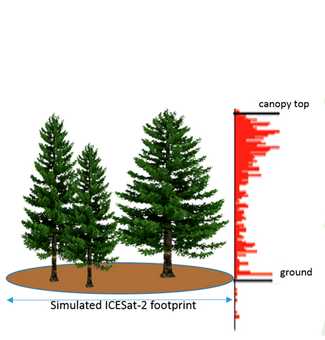
The Trees Around the GLOBE Student Research Campaign will host an Intensive Observation Period (IOP) during the month of January 2019 (winter in the Northern Hemisphere, summer in the Southern Hemisphere). This is the first of four IOPs that will be held during the campaign: January 2019, Tree Height; April 2019, Land Cover; July 2019, Tree Height; and October 2019, Land Cover.
During this IOP, students will:
- Take measurements of tree height and one additional protocol (from the suite of campaign protocols found at: https://www.globe.gov/web/trees-around-the-globe/overview/start-taking-measurements);
- Take measurements at least three times per week for one month at the same study site for both protocols (tree height measurements should be of the same trees each time for each site; there can be multiple sites, thereby increasing the number of trees measured);
- Report the number of tree height measurements and identify the additional protocol measurement and number of measurements by the fifth day of the following month.
Every participant will receive a Virtual Tree Height IOP Badge!
The GLOBE school with the most collected tree height data and additional protocol data will receive:
- Virtual Tree Height IOP Winner Badge
- Virtual one-on-one Q&A session with a NASA scientist, researcher, or engineer.
The primary goal of this IOP is to have students compare their measurements seasonally and with other GLOBE school measurements from around the world.
To learn more about the Trees Around the GLOBE campaign, including how to start taking measurements, how to retrieve relevant data, how to view ICESat-2 Satellite data, and how to connect to the campaign community, click here.
Getting Ready for the 2019 IVSS? Projects Due 10 April 2019

Are you getting ready for the 2019 International Virtual Science Symposium (IVSS)? The IVSS is a place for K-16 (primary to undergraduate) students from around the world to share their GLOBE research with other students, teachers, STEM professionals, and community members in an entirely online platform.
Projects are due on 10 April 2019.
Informational Webinar
On 25 October, Dr. Julie Malmberg hosted an informational webinar. The webinar provided an overview of the 2019 IVSS and a look at the updated virtual badges.
If you missed the webinar, or would like to view it again, click here!
Judges Needed!
Attention GISN members, STEM professionals, GLOBE alumni, GLOBE teachers, and other GLOBE community members! Would you like to help judge projects for the 2019 IVSS? Please fill out the form on this page! Also, please share this link with anyone you know who may be interested in helping score projects. More information will be sent to judges in early 2019.
Need Assistance?
Attention GLOBE students and teachers! Do you need assistance from a mentor scientist or STEM professional? Let us know by filling out the form on this page.
Timeline:
The 2019 IVSS Timeline:
- Informational Webinar: 25 October 2018
- Reports Accepted: 01 January 2019 to 10 April 2019
- Due Date for Student Reports: 10 April 2019
- Judging Webinar: 25 April 2019
- Judging Period: 26 April to 05 May 2019
- Feedback and Virtual Badges Shared: 17 May 2019
- Drawing for Stipends: 17 May 2019
For more information on the IVSS, click here!
Updated Dates/Locations Announced for the 2019 U.S. Regional Student Research Symposia
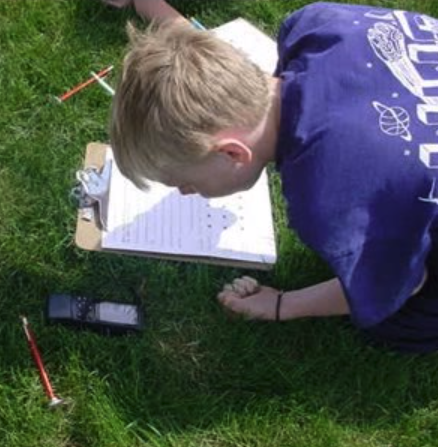
U.S. GLOBE Community: The dates and locations of the six regional Student Research Symposia (SRS) have been announced!
The 2019 SRS will give students (grades 5-12) from across the United States the opportunity to come together, face-to-face, and share the results of their field investigations using GLOBE protocols (or data from the GLOBE database) with peers and professional scientists. The SRS will enable students to learn from each other, receive feedback on their research, and explore STEM careers.
The schedule for the 2019 SRS:
- Midwest Region: 04-07 April (Cedar Falls, Iowa)
- Pacific Region: 26-27 April (Sausalito, California)
- Southeast Region: 03-04 May (Atlanta, Georgia)
- Northwest Region: 03-04 May (Seattle, Washington)
- Southwest Region: 17-19 May (Mescalero, New Mexico)
- Northeast/Mid-Atlantic Region: 31 May-01 June (Boston, Massachusetts)
To learn more about the SRS, click here.
Attend Upcoming SRS Watercooler Meetup: 18 December

Join the GLOBE Professional Learning Community (PLC) and hear how other GLOBE teachers use GLOBE with their students during a Teacher Watercooler meet-up on Tuesday, 18 December (7:00 p.m. EST). Watercoolers are a casual, collaborative, and supportive environment. They are scheduled once a month throughout the academic year
At this Watercooler, Jeff Bouwman will talk about #GettingScienceDone with GLOBE at Shumate Middle School in Michigan; Wanda Hathaway will talk about conducting aerosol research at Elizabeth City Middle School in North Carolina.
To register, click here.
More Languages Now Available on the GLOBE Observer App!
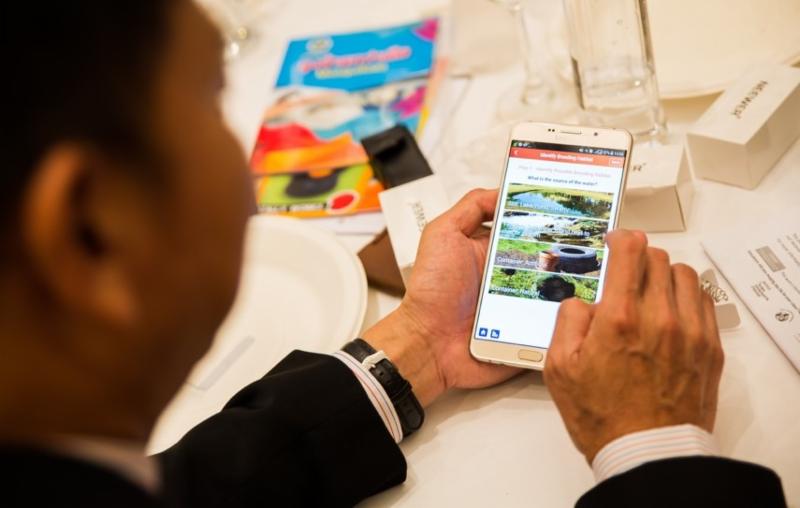
The GLOBE Observer App now offers nine different languages translations: Arabic, Dutch, English, French, Hindi, Portuguese, Russian, Spanish, and Vietnamese!
The GLOBE Observer App extends the reach of The GLOBE Program by providing a way for you, as a citizen scientist in a GLOBE country, to make observations and contribute to the GLOBE community. Your GLOBE observations help scientists track changes in clouds, water, plants, and other life in support of Earth system science research. Scientists can also use your data to help interpret NASA and other satellite data.
If you’d like to change the language on your account, simply visit your profile settings within the app and select “Change Language.”
For more information on the GLOBE Observer App, click here!
GLOBE Clouds: New Satellite Match Table Available!
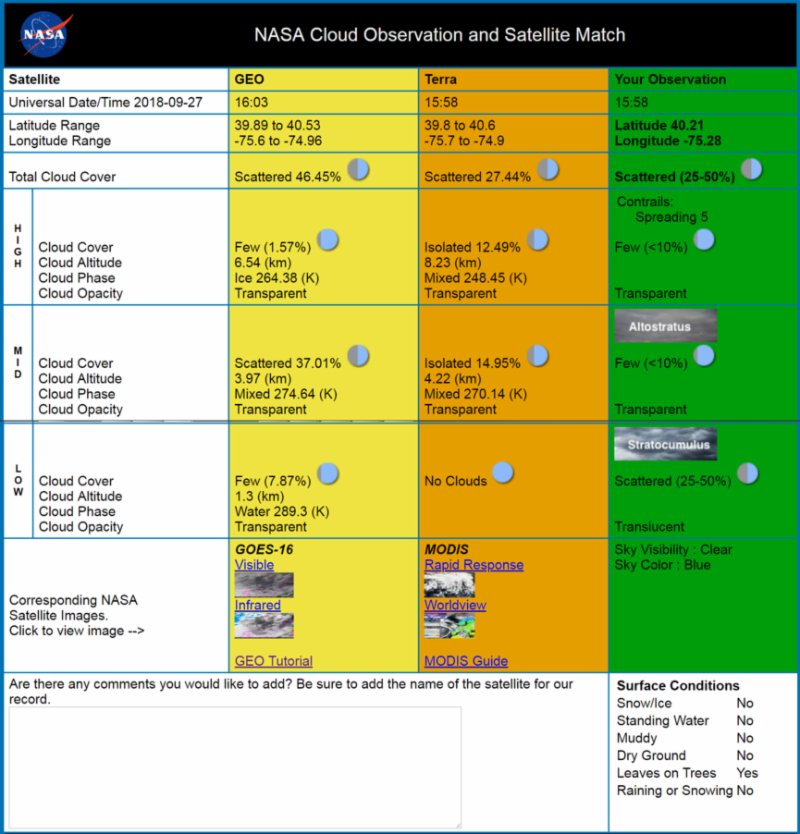
The table allows you to compare what you saw and what the satellite noted. You also have the actual satellite image at the bottom of the table! A new "How to Read a Satellite Match" page is available for you to learn more about the new design.
Researchers are excited to have observations from you, the ground observer, with images of clouds, that are "matched" or taken about the same time as a satellite over your area. While observations are useful at any time, your ground reports can help verify satellite measurements if you take your observations during a satellite overpass. You may be able to match to Aqua, Terra, CALIPSO, or Geostationary satellites.
Use the satellite overpass tool to see when a satellite will be over your area.
To check out more tips from the GLOBE Clouds team, including how to come up with a good research question, click here!
The GLOBE Zika Education and Prevention Project Continues in Asia and Pacific Region
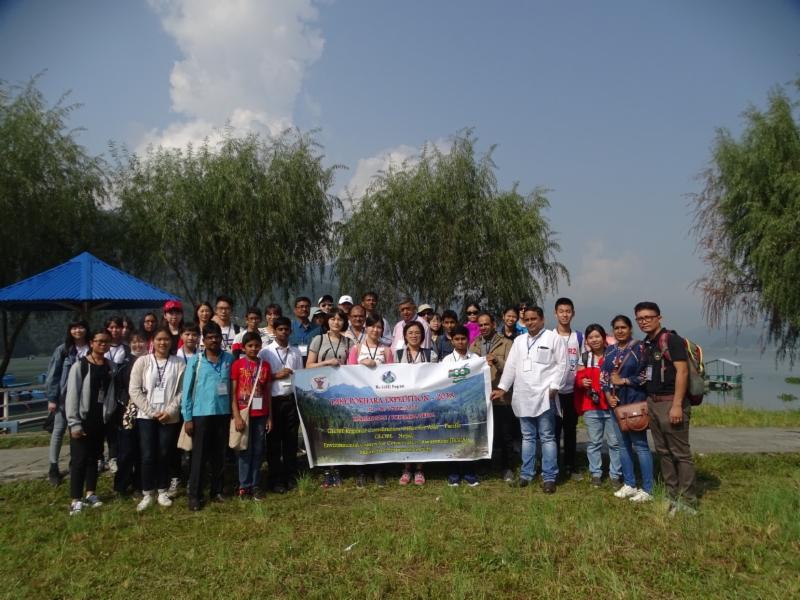
As part of the GLOBE Zika Education and Prevention Project, nine countries from the Asia and Pacific Region (India, Marshall Islands, Micronesia, Nepal, Palau, Philippines, Sri Lanka, Thailand, and Vietnam) are conducting Country Mosquito Trainings (CMTs). The goal of these CMTs is to train public health officials, teachers, and community leaders on how to use the Mosquito Habitat Mapper (found within the GLOBE Observer app) to limit the spread of mosquito-borne disease. Participating countries are quickly moving forward on this effort, having already conducted 30 CMTs throughout the region.
Funded by the U.S. Department of State, this exciting project enlists citizen scientists from 27 countries in Zika-affected regions in the collection and mapping of mosquito data. CMTs are the second round of trainings for this project, following Regional Mosquito Trainings (RMTs), which occurred in GLOBE’s Latin American and Caribbean, Asia and Pacific, and Africa regions earlier this year. RMT participants were trained in how to safely collect mosquito data using the Mosquito Habitat Mapper, as well as how to carry out CMTs. All of the CMTs taking place around the globe are the result of engaged GLOBE participants who were trained at the RMT level. This approach is known as a “train-the-trainer” model and is central to the success of the GLOBE Zika Education and Prevention Project.
The Asia and Pacific Region is well into the CMT process, having already trained approximately 900 people in the use of the Mosquito Habitat Mapper. One recent training in the Philippines was conducted in conjunction with the “Smart City Summit,” which was held in Quezon City on 18 October 2018. The audience included national and international government officials, members of the business sector, non-governmental organizations, and the general public. As exhibited by the Smart City Summit, CMTs can be carried out in partnership with existing trainings and events, which enables even more people to be trained in the Mosquito Habitat Mapper.
Training is also occurring outside of official CMTs throughout the region. From 02-08 October, 44 students and teachers from Taiwan, Oman, Thailand, India, and Nepal participated in the Lake Pokhara Expedition in Pokhara, Nepal. This scientific and cultural exchange, coordinated by the Regional Coordination Office for the Asia and Pacific Region (in association with Indian Environmental Society, and in collaboration with Environmental Camps for Conservation Awareness) trained participants in the Mosquito Habitat Mapper, as well as in the use of GLOBE hydrology, soil, and atmosphere protocols.
To learn more about this critical project, click here.
News Brief Archive
All past issues of the GLOBE News Brief are available in the online Archive.

News origin: GLOBE Implementation Office





